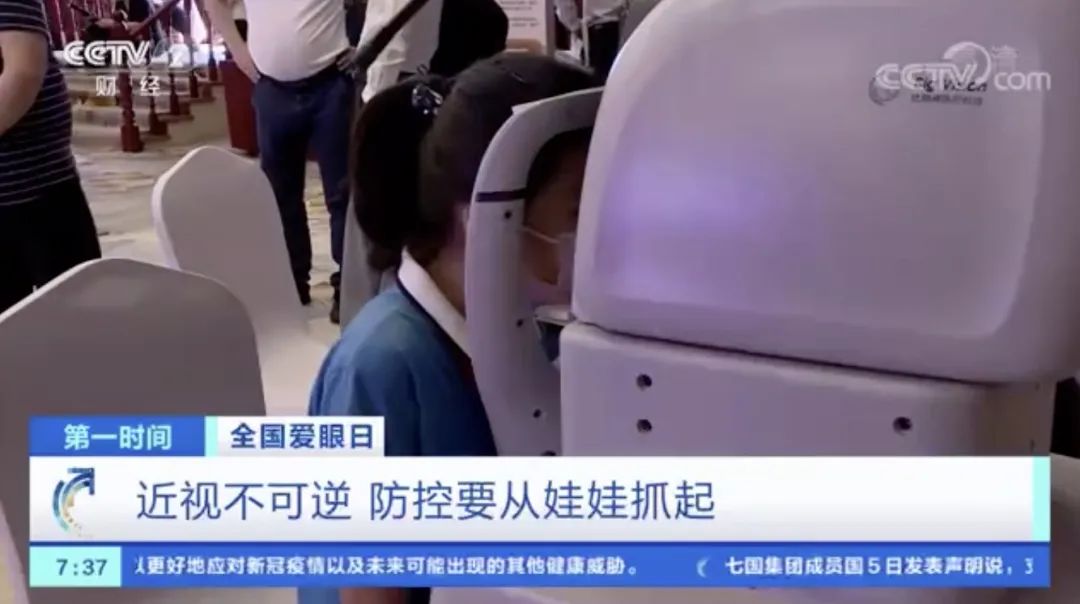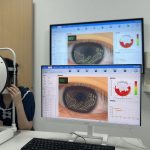Highlights of the “National Eye Health Plan for the 14th Five-Year Plan”
Focusing on the prevention and treatment of eye diseases, the diagnosis, treatment,
and long-term management of fundus diseases have become new key points.

The newly released plan explicitly stated that it is necessary to “improve the early diagnosis and treatment of fundus diseases such as fundus diseases and glaucoma. Promote the early detection, diagnosis, and treatment of fundus diseases such as diabetic retinopathy, myopic choroidal neovascularization, age-related macular degeneration, retinal vascular occlusion, and hypertensive retinopathy, formulate key disease diagnosis and treatment standards, improve the management model for patients with chronic eye diseases, and reduce the burden of diseases and blindness.”
With the aging population and changes in lifestyle habits in China, age-related, metabolic, and highly myopic-related fundus diseases such as diabetic retinopathy and age-related macular degeneration have become the primary causes of irreversible blindness, accounting for 54.7% of all blind patients.
“There are more than 40 million fundus disease patients in China, and the distribution of medical resources is still uneven. As the most important blinding eye disease in China, the clinical situation of fundus diseases can be said to be a heavy task, and has far-reaching impacts on social life and economy. This is also the main reason why the country added fundus diseases as a new disease category in this year’s National Eye Health Plan for the 14th Five-Year Plan,” said Professor Xu Xun, a member of the expert group who participated in the policy discussion for the National Eye Health Plan for the 14th Five-Year Plan and director of the National Clinical Research Center for Eye Diseases in a recent interview.
Compared with cataracts and glaucoma, the general public’s awareness of fundus diseases is generally insufficient, and the disease awareness rate is very low, which is easily overlooked by middle-aged and elderly people. Most fundus disease patients have not yet formed the concept of standardized treatment and regular fundus screening. In addition, as a complex eye disease, the treatment level of fundus diseases in grassroots areas is far behind that of first-tier cities, which has led to a large number of fundus disease patients in China not being diagnosed and treated in a timely manner, missing the golden treatment period, and ultimately losing their sight. According to statistics, more than 3 million new fundus disease patients enter hospitals in China every year, but the correct treatment rate is less than 10%.
The inclusion of fundus diseases in the key eye diseases range in the National Eye Health Plan for the 14th Five-Year Plan is in response to the actual changes in the social population distribution and blindness spectrum of eye diseases in China, and it has important practical significance. During the Retina China 2021, the China Forum on Fundus Diseases and International Symposium on Retina, many ophthalmology experts jointly called for an increase in public awareness of fundus health and care for fundus disease patients, and May 28, 2021, became the first “National Love Your Eyes Day” in China. We look forward to a significant increase in the public awareness rate and standardized treatment rate of fundus diseases during the 14th Five-Year Plan period.
Comprehensively moving the prevention and control of myopia in children and adolescents to a earlier stage is key to winning the battle against myopia.

During the “Thirteenth Five-Year Plan” period, General Secretary Xi Jinping has issued important instructions and directives on children and adolescents’ myopia problems many times, calling for “the whole society to take action and jointly care for children’s eyes to give them a bright future.” The country has successively formulated and issued the “Comprehensive Implementation Plan for Preventing and Controlling Children and Adolescents Myopia,” the “Guidelines for Myopia Prevention and Treatment,” and the “Suitable Technical Guidelines for Myopia Prevention and Control in Children and Adolescents” to guide the prevention and control of myopia nationwide. The prevention and control of myopia among young people has been actively promoted throughout the country.
In the newly released plan, the goal of “covering over 90% of eye health and vision checkups for 0-6 year-old children annually” is included in the “Fourteenth Five-Year Plan” eye health objectives, which require “promoting monitoring and intervention of myopia and risk factors in children and adolescents, carrying out special monitoring of myopia through the national student common disease and health influencing factor monitoring system, striving to achieve 100% coverage of myopia monitoring in counties (districts) nationwide during the ‘Fourteenth Five-Year Plan’, dynamically grasping the changes in the myopia rate and risk factors of children and adolescents across the country.”
Professor Wang Ningli, director of the National Expert Consultation Committee for Children and Adolescents’ Vision Health Management and director of the Ophthalmology Center at Beijing Tongren Hospital, pointed out when interpreting the “Fourteenth Five-Year Plan” National Eye Health Plan that “myopia prevention and control should be shifted to the earlier stage.” The plan emphasizes strengthening eye health and vision check-up services for 0-6 year-old children before starting school, advocating prevention and physical fitness to prevent myopia and encouraging ophthalmologists to conduct science popularization and carry out health month activities in primary and secondary schools.
Before the age of six is a critical period for children’s visual development. If their vision does not develop normally during this time, it will be difficult to make up for it in the future. Therefore, parents need to have awareness of myopia prevention and control from the birth of their child. At the same time, if the child has 150-200 degrees of farsightedness reserve at the age of six, the probability of myopia occurrence in primary school can be greatly reduced. In June 2021, the National Health Commission formulated and released the “Regulations on Eye Health and Vision Check-up Services for 0-6 Year-old Children (Trial),” aiming to detect common eye diseases, poor vision, and insufficient farsightedness reserves in children at an early stage, timely refer and intervene, control and reduce the development of controllable eye diseases and poor vision in children, and prevent myopia from occurring.
At the same time, the newly released National Eye Health Plan also pays attention to visual damage caused by high myopia. The plan sets the goal of gradually reducing the number of people with visual impairment caused by high myopia, requiring “strengthening early warning and intervention for patients with high myopia, improving the ability of early diagnosis and control of myopia, and reducing visual impairment caused by high myopia.”
According to the seventh national population census data of China, there were 253.38 million children aged 14 and below in China at the end of 2020, accounting for 17.95% of the total population. There is a huge population base for the prevention and control of myopia in children and adolescents. Meanwhile, affected by the epidemic, children and adolescents have less outdoor activities and increased use of electronic products indoors. To achieve the targets of “90% coverage rate of annual eye health and vision check-up for children aged 0-6” and “100% monitoring coverage of myopia in all counties (districts) nationwide”, and to achieve the overall goal of myopia prevention and control proposed in the Implementation Plan for Comprehensive Prevention and Control of Myopia in Children and Adolescents by 2030, there are still severe challenges, which require joint efforts from government departments, schools, families, medical institutions and children and adolescents themselves. Only by doing so can we win the battle against myopia.
Build a service system and enhance the ophthalmic diagnosis and treatment abilities at the grassroots level

Improving the diagnostic and treatment abilities of ophthalmology at the grassroots level remains a policy priority. The reality of inadequate and unbalanced allocation of ophthalmic medical resources in China will persist for a long time. The prevention and control of myopia in children and adolescents and the prevention and treatment of fundus diseases are long-term systematic projects. It is difficult to fully meet the growing demand for eye health services of the people solely relying on limited numbers of tertiary hospitals. The new plan issued this time puts emphasis on optimizing the allocation of ophthalmic medical resources.
On November 3, 2021, the Medical Administration Bureau of the National Health Commission issued the “Comprehensive Capacity Enhancement Plan for County Hospitals under the ‘Thousand-County Project’ (2021-2025)”, which aims to bring at least 1,000 county hospitals nationwide up to the level of tertiary hospitals within 5 years. This plan proposes combining the ophthalmic service system with the “Thousand-County Project”, continuously promoting the construction of ophthalmology-related medical consortia, promoting step-by-step coverage of fundus photography screening technology in primary medical and health institutions, exploring the establishment of a “grassroots examination, superior diagnosis” service model, and improving the diagnostic and treatment capabilities of fundus diseases, glaucoma and other eye diseases. It also emphasizes the implementation of technical schemes for graded diagnosis and treatment of ophthalmic diseases such as diabetic retinopathy, promotes the implementation of the “Thousand-County Project”, builds slow disease management centers in county-level comprehensive hospitals, steadily promotes family doctor contract services, and constructs an eye disease and chronic disease management system.
The plan proposes to gradually establish and improve a five-level ophthalmic medical service system at the national, regional, provincial, city, and county levels, and promote the expansion and downward extension of high-quality ophthalmic medical resources. It strengthens the establishment and construction of ophthalmology in comprehensive hospitals above the second level, and makes up for the shortcomings of ophthalmology and its supporting disciplines. Each prefecture-level city should have at least one independent ophthalmology department in a comprehensive hospital at or above the second level. Encourage qualified county-level comprehensive hospitals to independently set up ophthalmology departments and provide outpatient services. Professor Zhou Xingtong from Fudan University Affiliated Eye, Ear, Nose and Throat Hospital said that “through the operation of the five-level ophthalmic medical service system, each link can perform its duties and collaborate, which will help gradually narrow the gap in ophthalmic medical service capabilities between regions and urban and rural areas, reduce patient flow across regions, and promote the implementation of tiered diagnosis and treatment.”
The plan also hopes that community hospitals will play an active role in ophthalmic medical services. According to the basic standards of community hospitals, the plan encourages qualified community hospitals to gradually provide ophthalmic medical services. Relying on urban medical groups and county-level medical consortia, it guides eye disease prevention and control and appropriate medical technologies to extend to the grassroots level, promotes effective vision screening, fundus screening technology, and other applications at the grassroots level, and implements measures for eye disease prevention and control.
The “14th Five-Year Plan” for eye health has vividly outlined a complete ophthalmic service system that is hierarchically clear, functions complementarily, and achieves win-win cooperation. The implementation of the “Thousand-County Project” and the improvement of the ophthalmic diagnosis and treatment capabilities at the grassroots level are both daunting tasks and also create huge development space for the eye health cause.
Combining emerging technologies, artificial intelligence has been included in the eye health plan for the first time.

Compared with the “13th Five-Year Plan” for national eye health, a notable feature of the “14th Five-Year Plan” is that it has a stronger emphasis on technological advancements, fully reflecting and summarizing the achievements of incorporating and applying advanced technology measures in eye health practices during the previous plan period. It also provides strong technical support for the high-quality development of eye health in the “14th Five-Year Plan” period.
Of particular note is that this is the first time that artificial intelligence has been included in the eye health plan. The “Plan” clearly states that it will “promote the deep integration of big data, artificial intelligence, 5G, and other emerging technologies with ophthalmic services, carry out the application of artificial intelligence in eye disease prevention, diagnosis, and follow-up, and improve the early screening capacity for eye diseases.” Additionally, the eye health plan has also created a specific chapter to elaborate on the “construction of an eye health service support platform” for the first time. In recent years, cloud platform technology has matured and is now widely applied in various sectors of the national economy and society. Platforms can be regarded as a new infrastructure and are crucial in enhancing the diagnostic and treatment capabilities and levels of medical institutions.
Using advanced technologies such as artificial intelligence and 5G to help primary eye doctors is a necessary path for improving the diagnostic and treatment capabilities at the grassroots level, solving the shortage of ophthalmic medical resources, and extending the reach of high-quality medical resources. During the “13th Five-Year Plan” period, ophthalmology was the most active medical field in China in terms of AI research and application. Long strides have been made in the development of AI-assisted diagnostic algorithms for ophthalmic imaging technologies such as fundus photography and OCT, as well as practical screening applications. What is gratifying is that many ophthalmologists have embraced AI as a new technology and have discovered an increasing number of clinical applications and scenarios where AI can perform well. At the recently held first Suzhou International Ophthalmic Artificial Intelligence Summit Forum, ophthalmology experts from across the country discussed new achievements and directions in ophthalmic AI research and application, generating considerable excitement and enthusiasm.
We have reason to believe that during the “14th Five-Year Plan” period, the application of AI in ophthalmic medical services will become more extensive and profound and will play a more positive role in the development of eye health services. Smart ophthalmology is on its way to us.
Strengthening the popularization of science and increasing public awareness of eye health is essential.

Each of us is responsible for our own eye health. Whether it’s preventing and treating myopia and fundus diseases in teenagers, we need to care for our eye health, understand basic eye health knowledge, have sufficient awareness of our eye health status, and develop good habits of protecting our eyes. Only when each of us participates and cooperates can we achieve the overall goal of eye health planning.
Therefore, the “14th Five-Year Plan” for eye health emphasizes the importance of popularization. The plan proposes to “establish a comprehensive public eye health science popularization knowledge base and science popularization platform. Leveraging the technical advantages of eye care professionals, utilizing new mainstream media to strengthen eye health education and increase public awareness of eye disease prevention and treatment, creating a good social atmosphere. Taking ‘focusing on common eye health’ as the main theme, and with National Eye Care Day, World Vision Day, and other key dates, strengthen eye health popularization. Guide eye care medical institutions to organize free clinics, popular science education, and other public welfare activities during peak periods such as summer and winter vacations for children and adolescents.”
Enhancing the general public’s awareness of eye health is of great significance for early screening and diagnosis of diseases. It is gratifying that through various channels and forms of popular science, the public’s awareness of eye health is constantly increasing. Many well-known ophthalmologists actively use short video platforms to explain various common knowledge about eye diseases such as myopia, which has been well received by the public. In 2021, CCTV launched a special program for National Eye Care Day, focusing on “focusing on common eye health”, comprehensively reporting on China’s eye health situation and work done, vigorously promoting the important significance of focusing on eye health throughout all ages and all stages of life, which has played a positive role in raising awareness of eye health.

“The National Eye Health Plan for the 14th Five-Year Plan” has painted a beautiful picture of national eye health for us. Despite the long and arduous journey ahead, we will eventually reach our destination. As a high-tech enterprise focusing on research, production, and sales of ophthalmic AI systems and intelligent hardware devices, Big Vision Medical Technology established its mission of “early detection of every problematic eye and providing the best treatment plan” at its inception. During the 14th Five-Year Plan period, we will forge ahead on the road of AI-empowered ophthalmic diagnosis and treatment, work together with all ophthalmologists, and build a bright future for our country’s eyesight.








No comments yet.